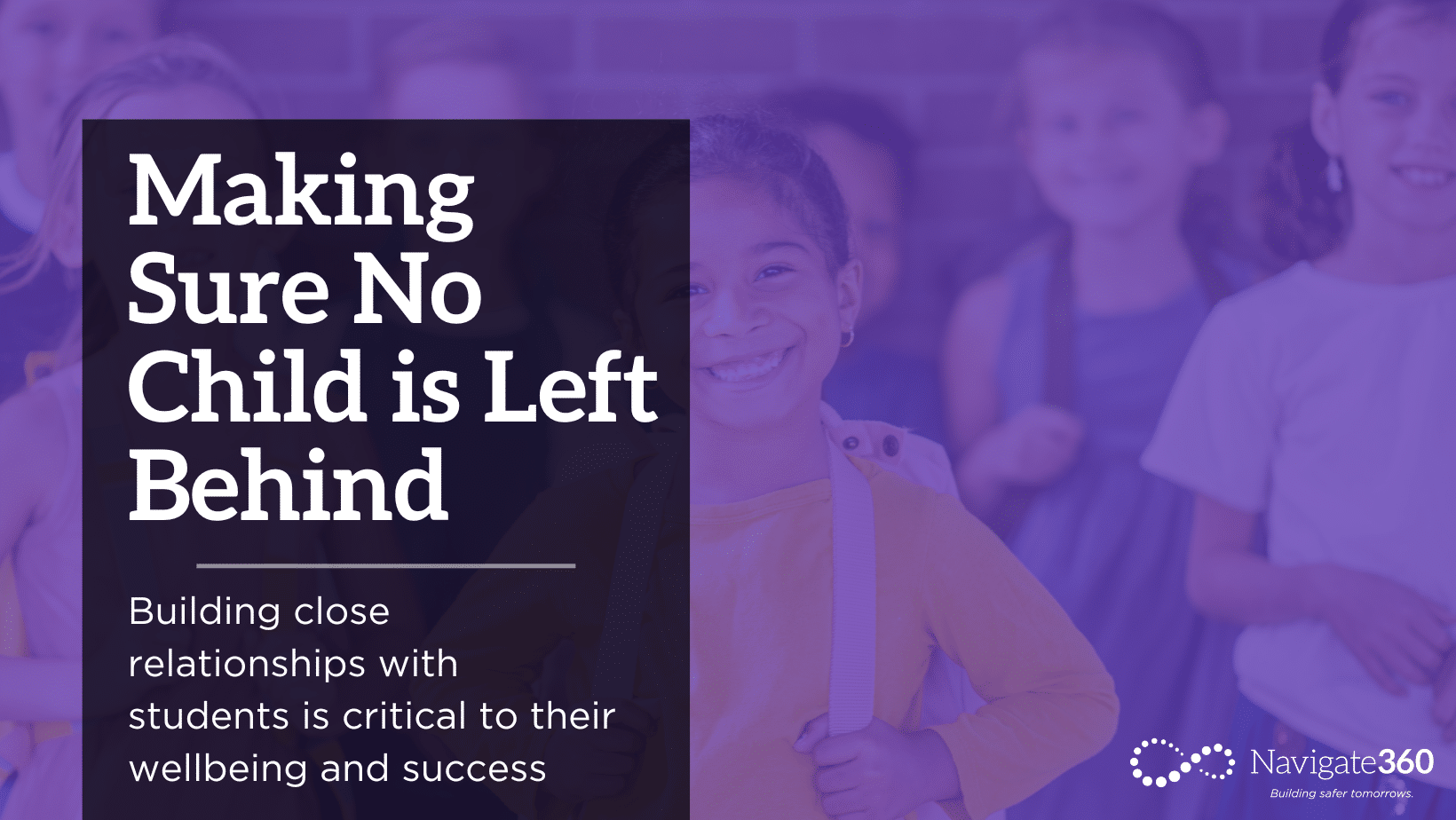Navigate360 – Building Safer Tomorrows™
Building a close relationship with students is critical to the wellbeing and success of our youth, but much more work needs to be done to make this a reality.
Want to Learn More about Social-Emotional Learning?
Navigate360 would love to talk to you about our comprehensive approach to social-emotional learning including products and services we offer that can help keep your students, faculty and organization thriving.
It was just another Monday afternoon faculty meeting. Upon scoping out the available snack options, I noticed posters placed around the room. As I took a closer look, my eyes locked on dozens of tiny portraits containing familiar faces spread across each poster like enlarged two-dimensional Guess Who frames. As our principal began the meeting, she explained that our task for that afternoon was to determine whether every single student in our building had a strong connection with at least one staff member. Our faculty would spend time rotating to each poster and placing a check mark underneath the students with whom we felt we had built a positive relationship.
The principal explained that classroom teachers were not to just think of whether a child was a former student, and our specialists were not to place check marks under all 400+ students who they undoubtedly see in their unified arts classes roughly once a week. The purpose of this task was not to identify students we taught, but to identify students we really knew and had made a personal connection with. She told us to think of the children who would light up when we made eye contact with them, or the ones who smile and wave their hand furiously to make sure that we see them, or those who take a moment to step out of their line and give you a fist bump, side hug or some other elementary-school-appropriate version of physical affection.
We got to work, knowing that our 90 minutes would pass by much more quickly than they do during our usual staff meetings. The energy in the room was palpable, and many teachers fondly shared memories of meaningful moments with various students. The check marks under some of our students grew to be quite long, and we decided that those students had more than enough positive adult relationships and we didn’t need to continue to add to the rainbow of sharpie marks underneath their photos. It also became quite clear that there were some students who had minimal checkmarks under their photos. Even worse, there were a couple of students who didn’t have a single checkmark. Seeing that blank space below a student’s school picture made my chest tight. To think that there were parents and caregivers who send their babies to school each day not knowing they don’t have a single close adult relationship within the walls of the building in which they spend more than six hours a day, 180 days a year, was almost too difficult to contemplate.
Making a Plan to Connect
Once we had a chance to visit each poster around the room, we returned to our seats and the real work began. The students who lacked adult connections were discussed individually and a plan was made to change that. Some of these children were relatively new to our school and hadn’t had much of a chance to get to know many adults in the building, but some were not, and it stung knowing that these little people had somehow slipped through the cracks. We carefully decided which staff members would be able to spend a few minutes of their day building a relationship with these children. Leaving this meeting with plans in place to make sure that every child in our building felt connected, supported and cared for in some way eased my guilt. I was hopeful that for these students, our efforts were not too late and that they would make a difference for them.
This activity was done for an elementary school in which students spend most of their day in one classroom. The ratio of staff to students was roughly 1:20 and many of our classes had assistants. Even still, there were students who didn’t have positive adult relationships. We all know that some students are harder to connect to than others, some are not consistently in attendance and some present with extreme social-emotional and behavior challenges. However, all it takes is a few minutes a day of purposeful conversation – not about school or academics, but about them; their likes/dislikes, their ideas, their interests, their hobbies – to make a difference. I think about middle schoolers and high schoolers who transition to many different classes throughout their day and who spend far less time with any one adult. There are likely far more students at those grade levels who have not made strong connections with adults in their school. Taking time to identify those students is more than just important: it’s critical and can make a world of difference.
According to Jinho Kim’s study on the quality of student-teacher relationships and their effects on long-term student health that was published by the American Psychological Association, “When students had positive relationships with teachers, the tended to have better physical and mental health as well as lower levels of substance use (Kim, 2020).” The findings of this study suggest that teacher-student relationships have a much more significant impact on student outcomes than student-student relationships. The implications of this research point to the importance of monitoring the quality of student-teacher relationships and implementing targeted interventions to improve these relationships.
Professional Development is Imperative
It’s important to recognize that there is very little training on ways to build relationships with students. It’s not even something that gets a lot of attention as teachers go through certification programs. The need for professional development on student social-emotional development, interpersonal communication and establishing a safe and warm learning environment is critical. With the current state of student mental health and wellbeing, this is not something we can afford to ignore, and the long-lasting implications of teacher-student relationships is one area that policy interventions might impact greatly. Imagine what could happen if we made sure that every student had someone in their corner, one adult they could trust, one teacher they could connect with at school? Maybe it could start with a single staff meeting.

About the Author
Brigette Chauvette
Brigette Chauvette is a senior curriculum manager for Navigate360. She is a former educator who has 12 years of extensive experience with emotional and behavioral differences. Brigette is on a mission to support teachers and students by making SEL an accessible and valued component in all schools.




